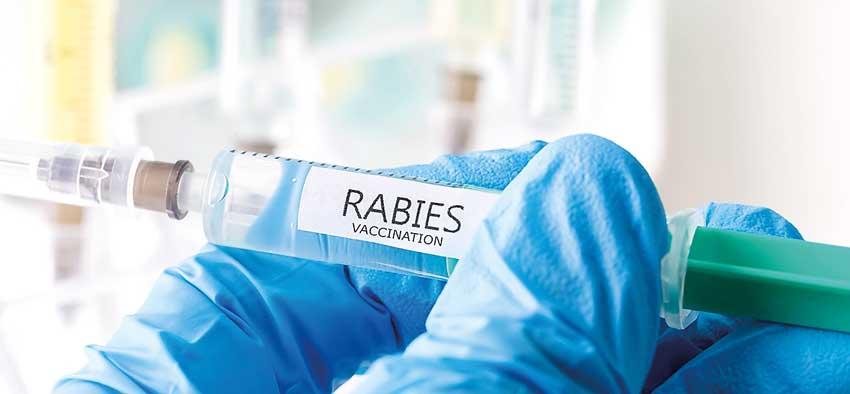22 Jan 2021 - {{hitsCtrl.values.hits}}

 Rabies has the highest fatality rate among any human infectious disease, as it is nearly 100% fatal if proper anti-rabies treatment is not administered promptly. Dogs, cats and other wild animals such as bats and squirrels are known to be main carriers of rabies responsible for transmitting the disease to humans.
Rabies has the highest fatality rate among any human infectious disease, as it is nearly 100% fatal if proper anti-rabies treatment is not administered promptly. Dogs, cats and other wild animals such as bats and squirrels are known to be main carriers of rabies responsible for transmitting the disease to humans.
Causative factors
Rabies is caused by different species of viruses which affect the nerves and the central nervous system. The virus enters the nerves near the wound and travel up along the spinal cord to the brain, causing a fatal encephalomyelitis (inflammation that affects the brain and spinal cord). From the brain the virus can travel down through nerves and spread to the salivary glands where another animal or human can be infected.
Transmission of rabies most commonly occurs through infected saliva from the bite of an infected animal, saliva contaminated scratches, or a lick on open wounds or mucous membranes such as the mouth.
The incubation period (the time till symptoms of rabies appear); depends on the amount of virus in the wound as well as the distance from the viral entry to the Brain and spinal cord. For example, wounds on face, neck, hands, genitals and multiple bites have shorter incubation period. It may be as short as a few days or as long as few years, or maybe around 1 – 3 months.
Symptoms
Rabies starts with non-specific flu like symptoms, such as low-grade fever, chills, muscle pains, weakness, sore throat, nausea, headache. This stage lasts from a few days to about one week.
Numbness or a tingling sensation at the site of wound is suggestive of a rabies infection. The bite victim becomes thirsty, but any attempt to drink causes throat spasms which make even the sight of water fearful leading to its most characteristic feature; Hydrophobia. This along with excessive salivation results in drooling. Sometimes even air can cause spasms leading to aerophobia.
The disease then enters a stage called furious rabies. This is characterised with alternating periods of manic, frenzied activity and calm. Spasms of throat muscles become progressively violent. The facial muscles may contract leading to a grimace, and the neck and back can become hyperextended with stiff muscles. Frequent convulsions will be seen. Finally, respiratory or cardiac failure leads to death.

Prevention
Firstly, all bite and scratch wounds must be washed thoroughly as soon as possible with soap and lots of water for at least 5 minutes. This greatly reduces the risk of infection. The victim must then be taken to the hospital where a series of rabies vaccines will be given immediately. In Sri Lanka anti-rabies vaccines are offered free of charge to people who are at risk of rabies from most government hospitals throughout the country with a few exceptions. Private hospitals do not usually offer the service.
The disease then enters astage called furious rabies.This is characterizedwith alternating periods of manic, frenzied activityand calm. Spasms ofthroat muscles become progressively violent
Vaccine and dosages
Based on the site and size of bite wounds, and the nature of the animal, you will be offered either the anti-rabies vaccine or for more serious cases; the anti-rabies vaccine plus another vaccine called rabies immunoglobulin is given. The anti-rabies vaccine is given in the form of 2 doses to both shoulders on admission to the hospital. For the vaccine to properly take effect, repeated doses must be given usually on 4 separate occasions based on current health guidelines. If the animal is alive with no change in behavior after 2 weeks following bite, the last few doses can be omitted based on doctors advise only. If you have been previously vaccinated against rabies within the last 5 years the vaccine is still needed but with fewer doses.
In addition, if the last tetanus vaccine you received was more than 10 years ago a single dose of tetanus vaccine too will be given to prevent tetanus infection.
All vaccinated individuals must keep the vaccination card in a safe place and must present it to the doctor if requested in the future.
Side effects
As with any medicine or food, allergies to the vaccines may occur in allergy prone people, however it is rare. Despite common myths, no food needs to be avoided to make the vaccine work and no food inactivates the vaccine.
Common side effects which can occur after vaccination are soreness, redness, swelling, or itching at the site of the injection, and headache, nausea, abdominal pain, muscle aches, or dizziness. Allergic hives, pain in the joints, or fever sometimes happen after booster doses.
Rabies is a terrifying disease and there is no cure once symptoms begin to show. However, it is nearly 100% vaccine preventable and even after bites and scratches from infected animals, getting treatment right away can stop the virus from spreading in your body and causing the disease.
(The writer is a fourth year undergraduate at the Faculty of Medicine, University of Kelaniya)
21 Dec 2024 33 minute ago
21 Dec 2024 2 hours ago
21 Dec 2024 5 hours ago
21 Dec 2024 5 hours ago
21 Dec 2024 6 hours ago